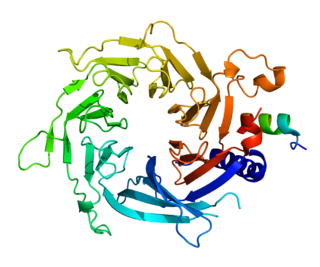Polycomb protein SUZ12 is a protein that in humans is encoded by the SUZ12 gene. [5] [6] [7] [8]
Polycomb protein SUZ12 is a protein that in humans is encoded by the SUZ12 gene. [5] [6] [7] [8]
This zinc finger gene has been identified at the breakpoints of a recurrent chromosomal translocation reported in endometrial stromal sarcoma. Recombination of these breakpoints results in the fusion of this gene and JAZF1. The protein encoded by this gene contains a zinc finger domain in the C terminus of the coding region. The specific function of this gene has not yet been determined. [8]
SUZ12, as part of Polycomb Repressive Complex 2 (PRC2), may be involved with chromatin silencing in conjunction with HOTAIR ncRNA, using its zinc-finger domain to bind the RNA molecule. [9]

In biology, histones are highly basic proteins abundant in lysine and arginine residues that are found in eukaryotic cell nuclei. They act as spools around which DNA winds to create structural units called nucleosomes. Nucleosomes in turn are wrapped into 30-nanometer fibers that form tightly packed chromatin. Histones prevent DNA from becoming tangled and protect it from DNA damage. In addition, histones play important roles in gene regulation and DNA replication. Without histones, unwound DNA in chromosomes would be very long. For example, each human cell has about 1.8 meters of DNA if completely stretched out; however, when wound about histones, this length is reduced to about 90 micrometers (0.09 mm) of 30 nm diameter chromatin fibers.

Histone methyltransferases (HMT) are histone-modifying enzymes, that catalyze the transfer of one, two, or three methyl groups to lysine and arginine residues of histone proteins. The attachment of methyl groups occurs predominantly at specific lysine or arginine residues on histones H3 and H4. Two major types of histone methyltranferases exist, lysine-specific and arginine-specific. In both types of histone methyltransferases, S-Adenosyl methionine (SAM) serves as a cofactor and methyl donor group.
The genomic DNA of eukaryotes associates with histones to form chromatin. The level of chromatin compaction depends heavily on histone methylation and other post-translational modifications of histones. Histone methylation is a principal epigenetic modification of chromatin that determines gene expression, genomic stability, stem cell maturation, cell lineage development, genetic imprinting, DNA methylation, and cell mitosis.

Histone deacetylase 1 (HDAC1) is an enzyme that in humans is encoded by the HDAC1 gene.

Histone deacetylase 2 (HDAC2) is an enzyme that in humans is encoded by the HDAC2 gene. It belongs to the histone deacetylase class of enzymes responsible for the removal of acetyl groups from lysine residues at the N-terminal region of the core histones. As such, it plays an important role in gene expression by facilitating the formation of transcription repressor complexes and for this reason is often considered an important target for cancer therapy.

Paired amphipathic helix protein Sin3a is a protein that in humans is encoded by the SIN3A gene.

Histone-binding protein RBBP4 is a protein that in humans is encoded by the RBBP4 gene.

Enhancer of zeste homolog 2 (EZH2) is a histone-lysine N-methyltransferase enzyme encoded by EZH2 gene, that participates in histone methylation and, ultimately, transcriptional repression. EZH2 catalyzes the addition of methyl groups to histone H3 at lysine 27, by using the cofactor S-adenosyl-L-methionine. Methylation activity of EZH2 facilitates heterochromatin formation thereby silences gene function. Remodeling of chromosomal heterochromatin by EZH2 is also required during cell mitosis.

Methyl-CpG-binding domain protein 2 is a protein that in humans is encoded by the MBD2 gene.

Histone-binding protein RBBP7 is a protein that in humans is encoded by the RBBP7 gene.

Sin3A-associated protein, 30kDa, also known as SAP30, is a protein which in humans is encoded by the SAP30 gene.

Polycomb protein EED is a protein that in humans is encoded by the EED gene.

Polyhomeotic-like protein 2 is a protein that in humans is encoded by the PHC2 gene.

Lysine-specific demethylase 2A (KDM2A) also known as F-box and leucine-rich repeat protein 11 (FBXL11) is an enzyme that in humans is encoded by the KDM2A gene. KDM2A is a member of the superfamily of alpha-ketoglutarate-dependent hydroxylases, which are non-haem iron-containing proteins.

Histone-lysine N-methyltransferase SETD7 is an enzyme that in humans is encoded by the SETD7 gene.

N-lysine methyltransferase KMT5A is an enzyme that in humans is encoded by the KMT5A gene. The enzyme is a histone methyltransferase, SET domain-containing and lysine-specific. The enzyme transfers one methyl group to histone H4 lysine residue at position 20. S-Adenosyl methionine (SAM) is both the cofactor and the methyl group donor. The lysine residue is converted to N6-methyllysine residue.

PRC2 is one of the two classes of polycomb-group proteins or (PcG). The other component of this group of proteins is PRC1.

The SET domain is a protein domain that typically has methyltransferase activity. It was originally identified as part of a larger conserved region present in the Drosophila Trithorax protein and was subsequently identified in the Drosophila Su(var)3-9 and 'Enhancer of zeste' proteins, from which the acronym SET is derived [Su(var)3-9, Enhancer-of-zeste and Trithorax].

The human KDM2B gene encodes the protein lysine (K)-specific demethylase 2B.

Yi Zhang is a Chinese-American biochemist who specializes in the fields of epigenetics, chromatin, and developmental reprogramming. He is a Fred Rosen Professor of Pediatrics and Professor of Genetics at Harvard Medical School, a Senior Investigator of Program in Cellular and Molecular Medicine at Boston Children's Hospital, and an Investigator of the Howard Hughes Medical Institute. He is also an Associate Member of the Harvard Stem Cell Institute, as well as the Broad Institute of MIT and Harvard. He is best known for his discovery of several classes of epigenetic enzymes and the identification of epigenetic barriers of SCNT cloning.